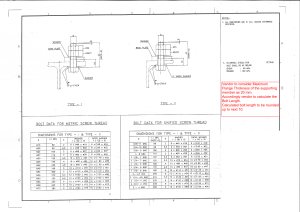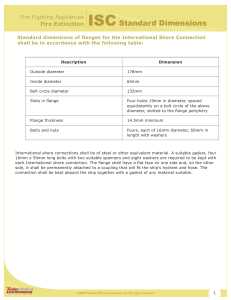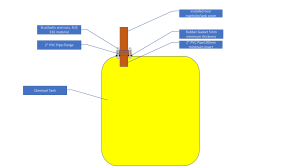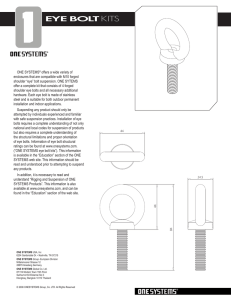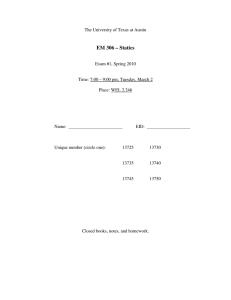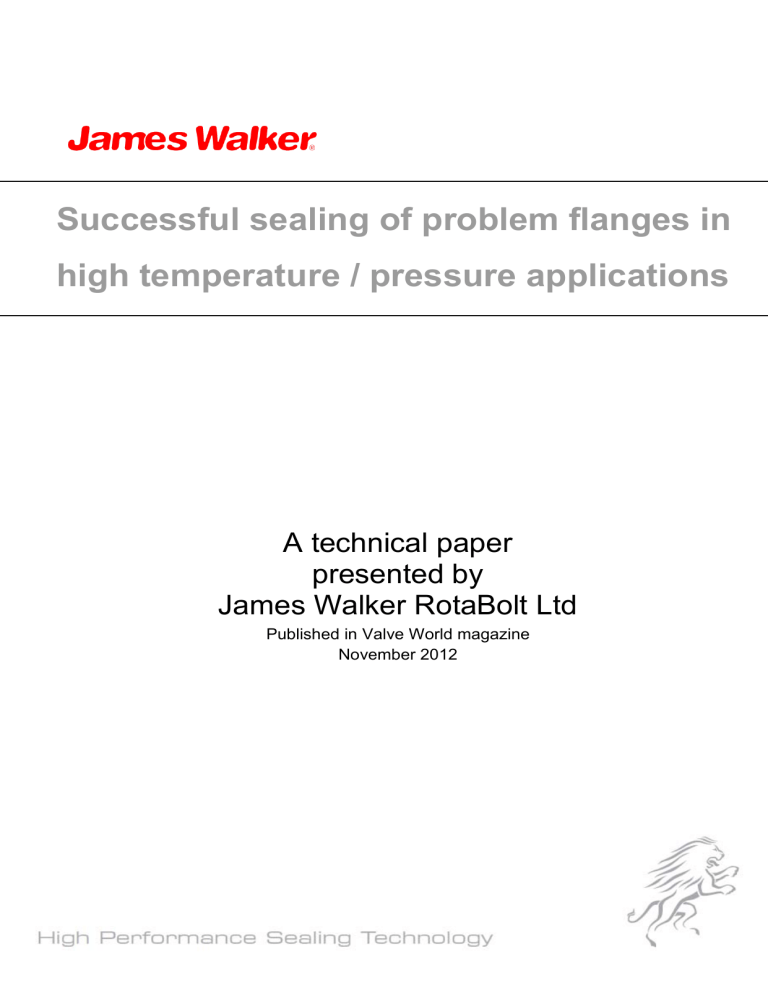
Successful sealing of problem flanges in high temperature / pressure applications A technical paper presented by James Walker RotaBolt Ltd Published in Valve World magazine November 2012 Ed Versluis Product Director - Flange Management Ed Versluis has worked for James Walker for over 12 years, specialising in bolted joint technology and its application to flange management in the petrochemical industry. He has been involved as a consultant in several root cause analyses of incidents caused by bolted flanged joint failures at petrochemical installations. Through ongoing research and work with customers in the field, his aim is to change the understanding of end users in the industry with regard to the 4 critical elements of bolted flanged joints - Design, Component quality, Quality of execution and Bolt tension. Only if all 4 elements are correctly controlled can you effectively achieve leak free performance of your bolted joints and Ed’s current work is focused on developing effective flange management regimes with refinery operators throughout Europe. Successful sealing of problem flanges in high temperature / high pressure applications Engineers from James Walker Benelux have been working with a number of European refinery operators to determine the best solution and engineering process for effective sealing of stainless steel pipe flanges in areas subject to high temperatures and pressures. The following article by Ed Versluis, flange management specialist at James Walker, explains the main causal factors of problems encountered with such flange joints and details the solution now employed as a result of this study and research. The investigation was initiated due to a number of instances of leakage from stainless steel flanges on desulphurisation units. With gasoil media at up to 400-430°C under pressures of around 8.3MPa (83bar) on some of these units, fire or explosion is a constant threat and serious fires had resulted from some flange leaks. The flanges in question were typically in 321 grade stainless steel incorporating an oval ring-type joint (RTJ) also in 321 grade stainless. These were bolted-up following standard engineering practise by torqueing or hydraulic tensioning to the recommended specification using ASTM A193 B16 grade carbon alloy bolts. In instances where leakage had occurred, a significant loss (in the region of 50%) of bolt tension had been found. Further to this, when the flanges were disassembled, damage was found on the RTJ groove in which the ring type gasket seats. The standard response to such flange leakages had been to re-weld and re-machine the RTJ groove of the flange faces and fit a new ring-joint. A lengthy and costly exercise, both in terms of man hours and lost production, but in many cases this did not solve the issue and a repeat failure occurred with similar distortion of the RTJ groove being caused. Detailed FEA computer modelling carried out as part of the investigation showed that this deformation was caused as a result of very high seating stresses on the ring type joint and the RTJ groove. As part of the investigation, the used rings were sent to James Walker Moorflex (API licensed specialists in metallic gaskets and metal machining) for examination to assess their quality. There have been various cases over the years in which we have seen instances where either flanges have been supplied in too soft a condition, as well as quite a few where rings have been supplied too hard and not properly annealed. Standard practice should see the use of ring type joints of a lesser hardness than the flange groove. The deformation should then be limited to the gasket and should in fact aid sealing of the joint. The following results from FEA analysis and testing on a purpose-built flange test rig clearly demonstrate that even a perfect RTJ correctly seated and assembled in a flange and bolted-up to the correct bolt tension will face the same seating stress issues with consequent risk of leakage in high temperature / pressure applications. It was this discovery that led the James Walker team to explore alternative gasket configurations in the search for a solution. FEA modelling The FEA modelling also determined that the very high seating stresses were being generated by the difference in thermal expansion between stainless steel flanges and B16 carbon steel bolts when the whole assembly went through temperature cycles potentially as great as ambient to 400-430°C and back to ambient. Figure 1 Figure 2 Figure 1 shows a simulation of the end of the tightening cycle, clearly demonstrating the seating stress being created between the RTJ gasket and the groove. The simulation assumes that all bolts where loaded to 234MPa bolt stress. Figure 2 simulates what occurs after one thermal cycle from ambient through 380°C and back to ambient with the whole assembly pressurized to 80 Bar. During the heating up phase the seating stress of the RTJ gasket will rise due the thermal growth of the assembly and plastic deformation between the RTJ gasket and groove could cause a catastrophic drop in bolt stress. There is only a narrow contact area between the RTJ gasket and groove in this type of flange assembly and the affects of thermal cycling have a critical effect on sealing performance. As the assembly heats up, it was found that the thermal expansion of the stainless steel flange would be in the region of 1.5 times greater than the expansion of the B16 bolts. The effect of the difference in materials being further amplified by a significant temperature difference between the flanges and bolts. Typically, during heat up when the flange reaches an operational temperature of 280°C the bolts are still relatively cold at just 80°C. Bolt stress therefore rises as the joint heats up and as a result seating stress between the ring type gasket and the RTJ groove also rises, to the point where plastic deformation occurs, in this case damaging the RTJ groove and compromising sealing. In the case of spectacle blind flanges these differences in expansion rates, combined with double the number of ring type gaskets in the joint and the expansion of the spectacle blind itself, creates an even more acute problem and not surprisingly it was found that spectacle blind flanges were the most susceptible to leakage. Test rig simulation These findings were explored in more detail on a purpose-built test rig, which allowed the effects of thermal cycling to be replicated on flanges using the identical gaskets, flange faces and bolts that were found on the operational plant. The rig was assembled using ring-type joints and bolts from standard suppliers and the flange secured using the recommended torque-tightening procedure. The joint was heated to 400°C and cooled back to ambient to simulate a typical process cycle. After cooling, a hydro test at 70 bar pressure was carried out to examine the load losses in the system, and the potential effect on sealing performance. After a single thermal cycle, the bolts were found to have lost tension and on disassembly the flange grooves were noted to have experienced some degree of deformation including damage to the groove recess flanks. These tests confirmed what had been seen in the FEA modelling and explained what engineers were finding when dismantling flanges. In some cases, the cumulative flange damage had increased over the years to such an extent that the gap between the raised faces had almost disappeared. This of course adds to the risk that leaks may occur if the RTJ is not sufficiently compressed in service. Kammprofile plus tension control bolting Using the same rig, an alternative bolting and gasket combination was put through the same test procedure, using the same flanges, which of course now showed signs of damage to the RTJ groove. This time graphite- faced Metakamm® kammprofile gaskets were used and the flanges bolted-up using carbon alloy RotaBolts. The RotaBolt® uses an internal mechanical strain gauge to monitor the tension achieved across the joint – a far more accurate method of bolting than traditional torque-tightening, which only gives an indication of the effort being put into tightening the bolt. Each RotaBolt is individually 100% load test calibrated on installation, the rotating cap on the top of each bolt / stud locks when the correct tension is achieved and continues to provide a simple check of bolt tension in operation throughout the lifetime of the bolted joint. Should tension be subsequently lost for any reason, the cap will freely rotate. The use of RotaBolts highlighted two factors that had undoubtedly contributed to the previous flange sealing failures. Firstly, the calculated load for some bolts was not reached at the traditionally used torque value and the torque had to be significantly increased to achieve the desired fastener tension. Some bolts on the other hand had passed the maximum allowable bolt tension during assembly. This served to highlight how potentially ineffective and inaccurate torquetightening can be. Torque scatters of ±30% are quite common. The variation in bolt tension is caused because each bolt has its own friction coefficient and by applying the same torque to all bolts the result is a ‘scatter’ of bolt tension. Bolt tension on installation The chart below shows the results of a test carried out on 6” 900# RTJ flange that had been converted to the kammprofile solution. The aim of the test was to discover whether a tension control system was required during joint assembly in order to overcome bolt tension ‘scatter’ and achieve a bolt stress level within the bandwidth between minimum required and maximum allowable bolt load. The tightening method used for the test was torque control, afterwards measured with tension control. When using standard B16 bolts and traditional torqueing on this 12 bolt flange only half the bolts were within the allowable range. This means that the joint is already subject to overload in some areas when the joint reaches the operating temperature, whilst at other points there is insufficient tension across the joint resulting in non-uniform compression of the kammprofile gasket. There is little chance of an effective seal across this joint after even a single thermal cycle as further bolting stress is lost. This could have a major impact on the time to leakage. Bolt stress in MPa 300 260 220 180 140 100 Bolt # 1 2 3 4 5 6 7 8 9 10 11 Bolt stress scatter due varying friction values with torque wrench Ideal (choosen) bolt stress maximum allowable stress on a flange minimum advisable bolt stress Using RotaBolts, the bolting stress on installation is evenly distributed and as close as possible (within ±5%) to the ideal. Thus, before heating commences, the joint is starting from the optimum position. Although minor relaxation was observed on some bolts after cooling when using the Kammprofiles and RotaBolts (indicated by the fact that the caps could spin or were dragging), once the flanges were heated back up to their operating temperature, the target bolt tension returned again due to the thermal expansion difference between bolts and flanges (demonstrated by the RotaBolt caps locking once again). Simple, effective solution From the viewpoint of a refinery operator, the ideal solution to leaking high temperature / high pressure flanges obviously needs to be cost-effective, simple to undertake and adopt as part of an ongoing maintenance schedule, and provide a lasting, safe seal on a critical piece of processing plant. Ring type joints are of course widely used on equipment handling very high pressures – in applications such as wellheads - but these pressures are usually at ambient temperatures and don’t involve the large thermal range involved in the processing cycles of a refinery. RTJs also require flanges to spread widely to allow installation and as we have already discovered, need flange grooves to be in excellent condition in order to provide an effective seal. The option of re-building and machining the flange faces to accept new rings is expensive and whilst an ‘upgrade’ from oval to octagonal rings may offer the potential for a better seal and help to minimise groove damage should high seating stresses occur, it doesn’t address the issue of loss of bolting tension caused during thermal cycling. Equally, eliminating the differential in thermal 12 expansion between the bolt and flange by switching to stainless steel bolts does not offer a suitable solution as the strength of stainless steel bolts is in most cases insufficient. Adopting the kammprofile gasket option requires no work to be carried out on the flange grooves as the gasket seals against the undamaged flange faces ‘inboard’ of the RTJ groove, where there is more than sufficient available contact area between the inside diameter of the groove and the inside of the pipe. The kammprofile gaskets can easily be scheduled by taking into account the ring groove dimensions and pipe schedules employed. As the gaskets operate at a high temperature the recommended facings are of very high purity graphite with an oxidation inhibitor which gives an improved high temperature performance over regular graphite grades. Some extra care may be required when installing kammprofile gaskets compared with the ring type joints they replace, as pipe alignment is to some degree assisted by the RTJ itself sitting in the grooves on the flange faces. In particular, on joints where line blinds are employed, these would normally be centred by the RTJ. To overcome this, and to ensure correct positioning of the kammprofile gaskets within such joints, bolt collars can be utilised to help align and hold the blind in position whilst the gaskets are installed. The Metakamm / RotaBolt solution has now been accepted as a safe and effective long-term sealing option and is operational across thousands of critical joints in European refineries with total success in leakage prevention. A number of operators have also changed their design and maintenance schedules to specify this sealing format in place of ring type gaskets for all high temperature / high pressure joints on stainless steel flanges where operational temperatures exceed the region of 200°C in order to eliminate the potential for flange damage and bolt tension loss with the consequent risk of leakage. James Walker worldwide sales and customer support James Walker Asia Pacific James Walker Deutschland James Walker Mfg (USA) James Walker Australia James Walker France James Walker New Zealand James Walker Benelux James Walker Iberica James Walker Norge (Belgium) Tel: +32 3 820 7900 Fax: +32 3 828 5484 Email: sales.be@jameswalker.biz Tel: +34 94 447 0099 Fax: +34 94 447 1077 Email: sales.es@jameswalker.biz (Netherlands) Tel: +31 (0)186 633111 Fax: +31 (0)186 633110 Email: sales.nl@jameswalker.biz James Walker Inmarco (India) James Walker Oil & Gas (USA) James Walker Brasil James Walker Ireland Tel: +65 6777 9896 Fax: +65 6777 6102 Email: sales.sg@jameswalker.biz Tel: +61 (0)2 9721 9500 Fax: +61 (0)2 9721 9580 Email: sales.au@jameswalker.biz Tel: +55 11 4392 7360 Fax: +55 11 4392 5976 Email: sales.br@jameswalker.biz James Walker China Tel: +86 21 6876 9351 Fax: +86 21 6876 9352 Email: sales.cn@jameswalker.biz Tel: +49 (0)40 386 0810 Fax: +49 (0)40 389 3230 Email: sales.de@jameswalker.biz Tel: +33 (0)437 497 480 Fax: +33 (0)437 497 483 Email: sales.fr@jameswalker.biz Tel: +91 (0)22 4080 8080 Fax: +91 (0)22 2859 6220 Email: info@jwinmarco.com Tel: +353 (0)21 432 3626 Fax: +353 (0)21 432 3623 Email: sales.ie@jameswalker.biz James Walker Italiana Tel: +39 02 257 8308 Fax: +39 02 263 00487 Email: sales.it@jameswalker.biz Tel: +1 708 754 4020 Fax: +1 708 754 4058 Email: sales.jwmfg.us@jameswalker.biz Tel: +64 (0)9 272 1599 Fax: +64 (0)9 272 3061 Email: sales.nz@jameswalker.biz Tel: +47 22 706800 Fax: +47 22 706801 Email: sales.no@jameswalker.biz Tel: +1 281 875 0002 Fax: +1 281 875 0188 Email: oilandgas@jameswalker.biz James Walker South Africa Tel: +27 (0)31 304 0770 Fax: +27 (0)31 304 0791 Email: sales.za@jameswalker.biz James Walker UK Tel: +44 (0)1270 536000 Fax: +44 (0)1270 536100 Email: sales.uk@jameswalker.biz JW4464 1112/pdf BP/DML4380 1012/1m PIIL2360697 Registered Office: James Walker Sealing Products and Services Ltd, Lion House, Oriental Road, Woking, Surrey GU22 8AP, United Kingdom. Reg No. 00264191 England © James Walker 2012
